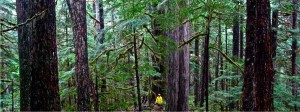Tongass old-growth on the chopping block
By Gabe Scott, Alaska Field Director
CORDOVA, AK—Big plans are in the works on Alaska’s Tongass National Forest, the nation’s largest.
It seems everyone has some grand scheme in mind for the largest remaining old-growth forest in the country.
The Forest Service is planning huge new timber sales, which they say will bridge the gap to a transition to second-growth. (As I type this post my inbox dings, announcing the arrival of a Decision to log over 6,000 acres of old-growth on Prince of Wales Island. Uh oh. Better make this quick).
The State of Alaska wants the feds to hand over 2 million acres of the Tongass so the State can manage them as a tree farm. Oh, Alaska. Our Governors say the cutest things.
Sealaska, the big regional Alaska Native corporation, is pushing land claims of its own, wanting some tens of thousands of acres to manage how it wants. This one has some merit – Alaska Natives are owed additional land. But surely there’s a better way.
The timber industry, through a lobbying group called the Southeast Conference, is pushing for a revised Forest Plan that would yield more and more profitable timber sales.
Conservation organizations like Trout Unlimited, The Nature Conservancy, and Audubon are pushing their own grand visions, which would permanently protect the most ecologically valuable acres from logging.
On top of the various visions are layered a bewildering array of collaborative working groups, teams, roundtables, task forces, committees and subcommittees.
The recent Tongass forest plan 5-year review presented an opportunity for Cascadia to put forward our own grand vision for the Tongass. Good! We were feeling left out. Here is what we had to say.
But here’s the thing. Every one of these grand visions and grand collaborative efforts has merit; and every one of them is doomed to fail. There are no silver bullets. No amount of new timber volume will bring back the good ‘ole days of logging. No amount of new designated Wilderness will ensure ecosystem health.
I for one wish we would all just stop looking for a final solution, and come to grips with the fact that living in harmony with nature is a life’s work. More than a life’s work, actually. Nobody has all the answers and nobody ever will. The best we can do is learn from our past, be honest about the present, and be cautious about what we leave for the future.
On the Tongass, we need to stop drawing maps, get our heads out of the clouds and our boots on the ground. Here on earth there’s good work to be done. There are hundreds of culverts blocking fish passage, for example, that everyone agrees need to be fixed, but that no-one is willing to take on because it’s hard, messy, expensive work. It will only be done by putting one foot in front of the other.
Don’t get me wrong, I love me some visionaries. But at the “end of the day” (is there even such a thing?), future generations won’t judge us by what we thought or what we said. They’ll judge us by what we DID.
In that vein, I’d better stop talking to you all and crack open the Big Thorne Timber Sale ROD. A hundred and forty-eight million board feet they say? Holy cow. We’ve got some work ahead of us.
